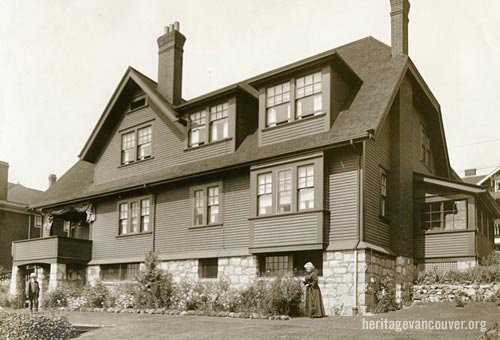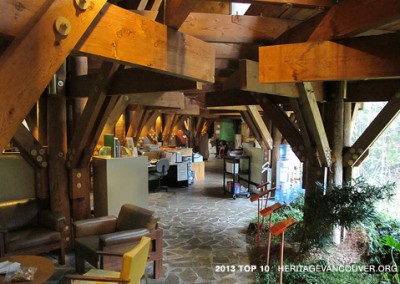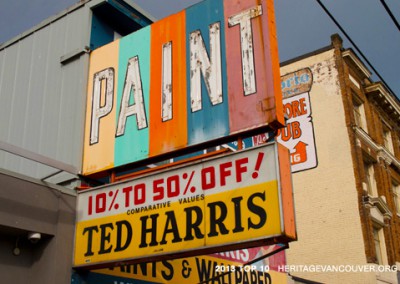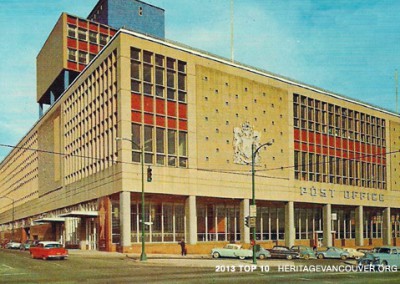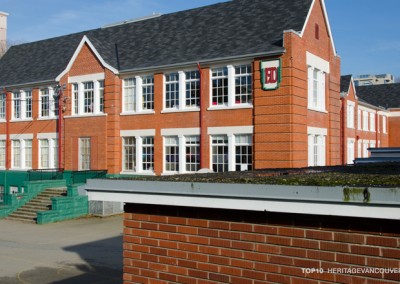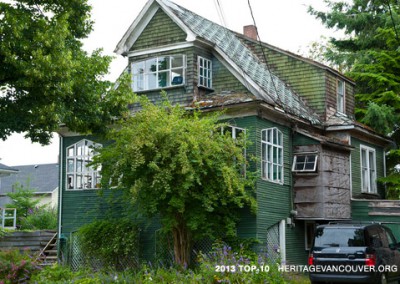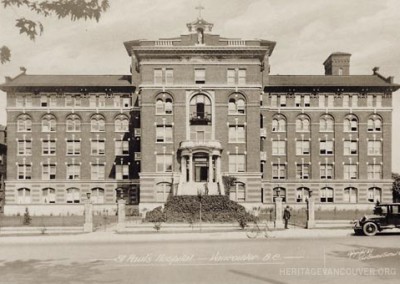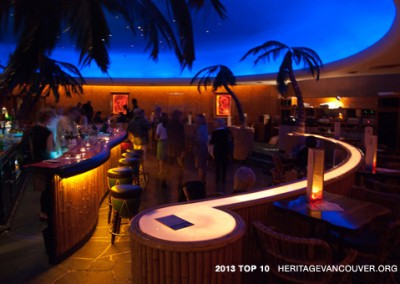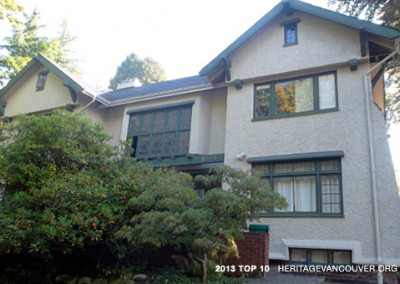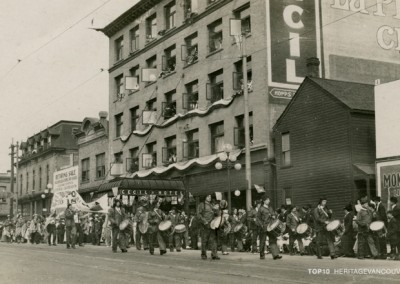The unique heritage buildings and varied heritage character of the West End are threatened by the City of Vancouver’s current development policies and the lack of incentives to adequately protect its heritage places. We have selected several buildings in the southwest corner of the West End to illustrate this point.
The Legg Residence, an “A” building at 1241 Harwood Street is currently facing demolition, and demonstrates the impact of the city’s decision to freeze it’s heritage density bank; the Gabriola Mansion at 1531 Davie Street demonstrates the city’s lack of capacity to end the extended boarding up of an “A” listed designated mansion; the three houses at 1301, 1309, and 1315 Davie Street illustrate the City’s failure to update its heritage register, and Maxine’s at 1215 Bidwell Street illustrates a token façade retention.
Some new City policies regarding heritage are encouraging. At the West End Plan Open Houses held in April 2013, Panel 9: Emerging Plan Directions, stated in #2 “Heritage includes: retain existing houses, retain a representative apartment block from each era, recognize Heritage Districts, recognize aboriginal history, recognize GLBT history.” The City has sent out a “call for proposals” to hire a consultant to write a Historic Context Statement for the West End. This will provide a high level view of the important heritage and historic themes of this neighbourhood. Although it will not name buildings that should be added to the Register it will create the potential for this to happen in the future.
Threat
What is the threat to West End heritage?
The threatened heritage of the West End is illustrated by the following examples:
Legg House (1899) – 1245 Harwood Street [update – demolished June 20, 2014]
The current fate of the Legg House, a unique and important reminder of the early days of Vancouver’s history and evaluated as a category “A”, remains unknown. Although slated for demolition, no development or demolition permit has been issued to date.
The Legg House proposal of May 2011 was five years in the making, followed all of the city’s own guidelines, had been approved by the city’s Heritage Commission and Design Panel, and was supported by city staff. The house was to have been restored, protected, and conserved in exchange for permission to build an 18-storey tower on site. This would have been accomplished through a ‘Heritage Revitalization Agreement,’ a mutually beneficial arrangement that allows increased density on the site and the protection of the house by heritage designation.
Council turned this proposal down and requested that the developer create a new proposal exploring retention of the site’s Tulip Tree. The developer’s revised proposal retained the tree and included a 17–storey tower, but demolished the Legg Residence.
As this proposal met West End zoning requirements, Council’s approval was not required and the Development Permit Board approved the application.
The imminent loss of this significant late Victorian-era residence, would be the third Heritage “A” building to be demolished in Vancouver in the last quarter century, joining the Marpole Safeway (2012) and the Georgia Medical-Dental Building (1989).
The demolition of the Legg House (in favour of saving a tree) could undermine the credibility of the City of Vancouver’s Heritage Program and send a profoundly negative message to other owners contemplating retention of a heritage building.
Gabriola Mansion (1901) – 1523 Davie Street
The Gabriola Mansion has been boarded up and fenced for several years now. One of the three surviving grand estate homes in the West End from the end of the 19th century, this fine stone house adds richness to the streetscape along with beautiful garden spaces and preserved views.
The “A”- listed Mansion has received protection with a Revitalization Agreement that included designation and a density bonus scheme. It is important that this designated building with its magnificent grounds be opened up to the public, so that it can be enjoyed again.
Heritage Houses (1901 & 1906) – 1301, 1309, 1315 Davie Street
The many delays in upgrading the City’s Heritage Register have left potential heritage buildings off the Register and ineligible from the city’s heritage program. In the case of Register buildings, potential developments are reviewed by the City’s Heritage Commission and approved by council. These historic wooden houses on Davie Street, built between 1901 and 1906, are examples of buildings that should be evaluated to determine their heritage value.
Currently, there is nothing to stop owners from tearing these buildings down and building anything from a new modern house to a high-rise. The threat to buildings such as these has increased in recent years with the introduction of the City’s Short Term Rental Incentives (STIR), intended to increase the number of rental properties in the West End. The density bonusing incentive given to owners who build rental units has been successful in increasing the number of rental units but has also increased the threat to vulnerable historic homes not on the Heritage Register, and may even threaten identified heritage sites.
Maxine’s (1936) – 1215 Bidwell Street
Housing trumps heritage. A wonderful 1936 Mission-revival heritage building, Maxine’s was demolished with the exception of its front facade and replaced with a 21-floor condo and rental tower – a “STIR” initiative. The development proposal included retaining the facade, considered in the Statement of Significance to be the building’s only significant heritage feature.
Heritage Vancouver, faced with either supporting the façade retention or the demolition of the building opted to support the façade retention that retained the front façade, including the original wood and glass doors and windows, and the use of the original facade as an entry to a public space, such as a café.
According to city staff, the doors of the building have been stolen and will be replicated by the developer; and the north end of the façade will be the entrance to a public facility.
We are uncertain at this time how successful the façade retention will be and are monitoring this development to ensure that the final façade communicates some idea of history and the new public space livens up the street once again.
Significance
Why is the West End significant?
One of the unique features of the West End is the layering of many periods of the city’s history as seen in a fascinating mix of heritage buildings from different eras. This blended history provides a wonderfully interesting urban mix of styles and types that results in uniquely varied streetscapes, enhanced by many mature street trees and luxuriant landscaping. It is this variety that makes the densely built West End so urban, livable and interesting. The Gabriola Mansion, the Legg Residence, 1301, 1309 and 1315 Davie and Maxine’s are important links to the history of both the West End and Vancouver.
The West End is located in the most densely populated, intensively active portion of the Lower Mainland. Bounded by West Georgia Street, Burrard Street, English Bay and Stanley Park, it shares the peninsula with the Downtown, Central Business District, Coal Harbour, Yaletown and Stanley Park. For the first few years after the founding of Vancouver in 1886, the West End was only sparsely settled, due to its distance from Gastown, the city’s birthplace. Starting in the 1890s, the remainder of the forest was logged and gradually replaced with grand Victorian homes for middle and upper-income families.
With the Canadian Pacific Railway’s development of Shaughnessy in the first decade of the new century, the West End’s role as Vancouver’s “exclusive” residential area shifted and the community’s next stage of development began. Apartments were built among single-family homes on tree-lined streets, houses along Robson, Denman and Davie Streets – all served by streetcar lines – were redeveloped as shops, and larger homes were converted into rooming houses.
During the 1930s and 40s, the next wave of apartment development occurred. These were low-rise structures, many with impressive Art Deco and Tudor-inspired facades designed to give the community an air of permanence and respectability.
The next stage of redevelopment in the West End began in 1958, when the 3-4 storey height limit was lifted and zoning changes permitted higher densities, resulting in the rapid replacement of houses with mid-rise and high-rise apartment blocks.
A change in zoning in the 1980s reduced the height and density of new buildings in the West End. The City introduced a by-law to preserve the rental housing stock, by preventing building conversions from affordable rentals to more expensive condominiums.
These two city policies meant that for several years there was very little pressure on heritage buildings in the West End. This was a time of notable heritage success stories including the development of “Barclay Heritage Square” and “Mole Hill“, and the retention of the Abbott House on West Georgia Street and “Gabriola” on Davie Street.
Position
Heritage Vancouver’s position
We strongly encourage the City of Vancouver to:
- Fund the upgrade of the City’s Heritage Register as an immediate priority. This initiative would go a long way toward identifying sites not listed on the Heritage Register at the time of its inception in 1986, and modern buildings not considered heritage thirty years ago. Such a move might preserve the three historic buildings in the 1300-block Davie Street and other West End locations.
- Move quickly to land the current density in “The Heritage Density Bank“, unfreeze the bank and broaden the areas where heritage density can be transferred. In the past, this was a very creative and effective preservation tool and we desperately need it to be available again. If a density transfer were made available there is still a possibility that the Legg Residence could be saved.
- Meet with the owners of the Legg Residence to determine if a solution can be reached to save this important “A” West End Mansion. Although the City gave the owner the right to demolish the building over a year ago, the building is still standing and functioning very well as a rental property. The building is a landmark and one of the three remaining turn-of-the nineteenth century heritage mansions.
- Find a way to reactivate Gabriola Mansion. In its current boarded-up and fenced-in condition residents and visitors to Vancouver cannot enjoy it. If the current owner does not intend to reopen it as a restaurant, it could be turned into a public amenity. The public is highly supportive of finding a community-based purpose to bring this magnificent heritage building back into use.
- Carefully supervise the Maxine façade restoration, ensuring the doors and windows are replicated, the façade is restored to the highest-level standards and that it opens on to a public space that recalls the lively days of Maxine’s. We also recommend interpretive panels in the new space with text and photos that tell the story of Maxine’s.
- Facilitate the creation of heritage nodes in the West End. The three houses we have identified on Davie Street are located a stone’s throw from the Gabriola Mansion and across the street from the recently revitalized B-listed Blenheim Court, and add to the heritage richness of the Davie-Jervis area. These houses could be restored as multi-residential units or turned into small cafes, galleries or specialty shops and contribute to the wonderful local heritage character of the West End.
- Consider offering small grants to owners of rental buildings. A grant to upgrade the electrical system or provide a new roof on the condition the building remain a rental building would be more cost effective than offering large density bonuses to demolish buildings to build new rental units in towers.
We strongly encourage the community of the West End and the people of Vancouver to:
- Continue positive communications with the City of Vancouver. To date, the successful community involvement and response throughout the West End Planning process has made a difference, as the importance of special heritage and character features of the West End were repeatedly brought up in meetings, community fairs and workshops and other events.
- Participate in City surveys and support the concept of low-rise laneway rental housing. Instead of tearing down buildings, this type of densification supports the retention of heritage buildings.
- Let the City of Vancouver know that the West End’s heritage matters to you. Continue to bring forward your stories about the history and heritage of the West End.
Actions
Updates
Update: June 20, 2014: After surviving for 115-years in the West End, the A-listed (Heritage Register) Legg Mansion was fully demolished June 20, 2014.
View Houses – West End in a larger custom Google map,
that we’ve built to track all heritage houses in the area.
